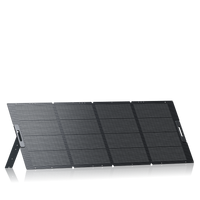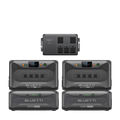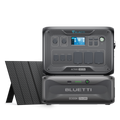Your cart is empty
Shop our productsWelcome to Solar Energy 101! If you are new to solar panels and generators, both the technology and the setting up process can seem challenging. That’s why we have put together this guide on the basics of solar panels and the basics of solar generators.
We will cover the basics as we dive deeper into what you need to know about using solar energy and understanding solar panels and generators.
Solar Panels 101
In this section, we will explore what solar panels are, how they work, and the different types available in the market.
What Are Solar Panels?
Solar panels convert the energy from the sun into electricity. They are composed of solar cells, which are made up of semiconductor materials like silicon. When sunlight hits these cells, electrons are released, creating an electric current that can power electrical devices and appliances.
Solar panels come in a variety of sizes and configurations, from small portable panels that can be used to charge mobile devices to large-scale installations that can power entire buildings or even cities. The most common type of solar panel is the flat-plate panel, which consists of multiple solar cells arranged in a grid-like pattern and encased in a weather-resistant material.
How Do Solar Panels Work?
Solar panels capture and convert the renewable energy present in sunlight into usable electrical power that can be utilized to provide energy for electrical loads. The panels are made up of individual solar cells that consist of layers of silicon, boron (which provides a positive charge), and phosphorous (which provides a positive charge).
The solar panels absorb photons from the sun, thereby producing an electric current through the photovoltaic effect. The resulting energy created by photons striking the solar panels’ surface allows electrons to be dislodged from their atomic orbits and released into the electric field produced by the solar cells, which pulls these free electrons into a directional current.
The metal plates on the sides of each solar cell collect the electrons pushed out by the electric field and transfer them to the connecting wires. At this point, the electrons move in the form of electricity through the metal wires to a solar inverter that supplies energy to your home.
Types of Solar Panels
There are several different types of solar panels, each with its unique characteristics, advantages, and disadvantages. Here are some of the most common types of solar panels:
1. Monocrystalline Solar Panels
Monocrystalline solar panels are made from a single, high-purity silicon crystal, which makes them highly efficient at converting sunlight into electricity. In fact, these cells have an efficiency ranging from 15% to 20%.
Monocrystalline solar panels conduct electricity more efficiently and work better in the shade and high temperatures, allowing them to produce more solar energy compared to other similar-sized panels. They are also durable and long-lasting. Nevertheless, they tend to be more expensive compared to other types of solar panels.
2. Polycrystalline Solar Panels
Polycrystalline solar panels are essentially fragments from several silicon crystals that are heated, melted, and compressed to make a large solar panel. These cells have a non-uniform, gemlike, and multifaceted surface and are typically blue in color. They come with a glass casing usually made from anti-reflective glass, along with a back sheet, which protects them against damage.
Polycrystalline solar panels are less expensive but also less efficient than monocrystalline solar panels, with an efficiency between 12% and 16%. These panels are the most commonly available solar panels internationally, mainly because of a production boom in China over the past couple of years.
3. Thin Film Solar Panels
This type of solar panel is made of a thin layer of photovoltaic material or a combination of materials, such as copper indium gallium selenide, cadmium telluride, or noncrystalline amorphous silicon deposited onto glass or metal. These solar panels are typically bigger and have a uniform, black appearance.
The efficiency of thin film solar panels is the lowest, ranging from 7% to 13%. However, their main benefits are that they are easy to manufacture, low-cost, portable, lightweight, and flexible. Nevertheless, they are less durable than monocrystalline and polycrystalline solar panels and have a shorter lifespan.
Solar Generators 101
In this section, we will explore the basics of solar generators and understand how they work.
What Are Solar Generators?
Solar generators are devices that convert solar energy from the sun’s rays into electrical energy, which can be used to power various electronic devices and appliances. They usually consist of solar panels, a battery, a charge controller, and an inverter. Solar generators typically have multiple outputs for charging several devices simultaneously.
There are different types of solar generators available on the market, ranging from small portable units that can power a single device to larger units that can provide enough power to run an entire home or cabin. The size and capacity of a solar generator depend on the amount of power needed, the length of time it will be used, and the number of devices that will be powered.
How Do Solar Generators Work?
A solar generator functions by generating electricity using sunlight and storing it in a battery for later use. Here’s a more in-depth breakdown of the process.
- The solar panels transform the energy from the sun into direct current (DC) electricity and pass it to the charge controller.
- The charge controller monitors the electricity’s voltage before storing it, making sure the correct amount of current enters the battery.
- The battery stores the solar power for later use.
- The inverter transforms the energy stored in the battery to alternating current (AC) electricity that most devices and appliances use.

Applications of Solar Generators
Here are some of the most common applications of solar generators:
1. Emergency Backup Power
Solar generators can provide reliable backup power during power outages caused by natural disasters, such as hurricanes, earthquakes, and floods. They can power essential devices like lights, refrigerators, and communication devices, keeping people connected and safe during emergencies.
2. Remote Power Supply
Solar generators are ideal for powering remote locations where access to the electrical grid is limited or non-existent. In fact, these devices can be used to power scientific instruments, communication systems, and off-grid homes, making it possible for people to live and work in remote areas.
3. Outdoor Activities
Solar generators are a popular power source for outdoor activities like camping, hiking, and RVing. If you’re a fan of outdoor adventures, you can use solar generators to power devices such as lights, fans, and refrigerators and make your trips more comfortable and convenient.
4. Mobile Power
Solar generators can be used to power mobile devices like smartphones, laptops, and tablets, making it possible to work and communicate while on the go. They can also be used to power electric vehicles and boats, providing a sustainable alternative to traditional gasoline engines.
Benefits of Solar Panels and Generators
There are plenty of benefits to using solar panels and generators, such as the ones listed here:
1. Cost Savings
Solar panels and generators can help you save money on your energy bills by reducing your reliance on grid electricity. Once you have installed a solar panel system or generator, you can generate your own electricity for free from the sun, reducing your energy costs over time.
2. Renewable and Clean Energy
Solar energy is a renewable and clean source of energy, which means that it does not produce harmful emissions like traditional fossil fuels. Thus, solar energy is an environmentally friendly option for power generation.
3. Energy Independence
With solar panels and generators, you can become more independent from the grid and have greater control over your energy usage. This is particularly useful in areas where the grid is unreliable or expensive.
4. Low Maintenance Requirements
Solar panels and generators require very little maintenance, making them a low-cost option for power generation. The panels themselves are durable and can last for up to 25 years with minimal maintenance, while the generators require only occasional cleaning and battery replacement.
5. Versatile Applications
Solar panels and generators can be used in a wide range of applications, from powering homes and businesses to providing energy for outdoor activities and remote locations. They can also be used in a variety of settings, from urban areas to rural communities.
6. Social Benefits
Solar panels and generators can provide significant social benefits, such as increased access to electricity in underdeveloped regions and improved energy security in areas prone to power outages. Solar energy can also create jobs in the renewable energy industry, providing economic benefits to communities.
How to Choose the Right Solar Panels and Generators?
Choosing the right solar panels and solar generators depends on several factors, including your power needs, budget, and the specific conditions of your location. Here are some key factors to consider when selecting solar panels and solar generators:
1. Power Needs
The first step in selecting a solar panel or solar generator is to determine your power needs. This involves estimating how much electricity you will need to power your devices and appliances. You can use online calculators or consult with a solar energy professional to help you determine your power needs.
2. Solar Panel Efficiency
Higher-efficiency panels will generate more power, but they may also be more expensive. Consider the available sunlight in your area and how much power you need to decide on the most efficient panel for your needs.
3. Battery Capacity
The battery capacity of a solar generator determines how much energy it can store and provide. Think about how long you will need the solar generator to run and how much power your devices and appliances require to determine the appropriate battery capacity for your needs.
4. Portability
If you plan to use your solar generator for outdoor activities like camping or hiking, consider the portability of the generator. Look for lightweight and compact models that are easy to transport.
5. Durability
Solar panels and solar generators are typically exposed to the elements, so it is important to choose durable models that can withstand harsh weather conditions. Ideally, you should choose models with strong frames and weather-resistant materials.
6. Cost
The cost of solar panels and solar generators can vary significantly. Factor your budget and search for models that provide the best value for your needs.
Invest in BLUETTI Solar Panels and Generators Today!
If you’re interested in investing in solar panels and generators to avail the massive benefits they offer, check out BLUETTI today. We have a vast range of solar products, including solar panels, solar generators, and portable power stations to keep you powered in all situations.
Shop products from this article
Be the First to Know
You May Also Like

What Does a 30% Federal Solar Tax Credit Mean and How to Apply?
Governments around the world are offering programs that encourage homeowners to switch to solar energy. Among the most notable programs is the 30% Federal Solar Tax Credit. It reduces your...

Deadly Flooding Devastates U.S. South and Midwest — What You Need to Know




































































































































































































































